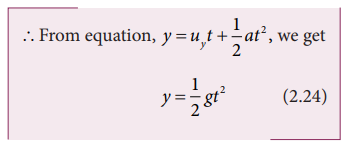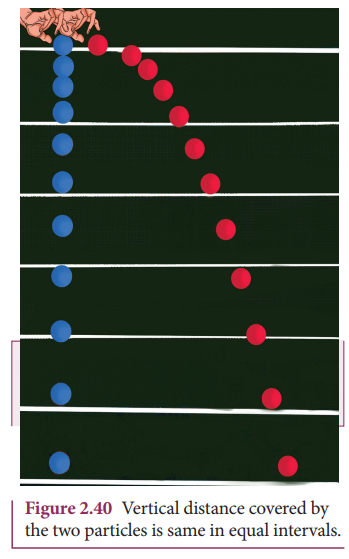Chapter: 11th Physics : UNIT 2 : Kinematics
Projectile Motion
PROJECTILE MOTION
Introduction
When
an object is thrown in the air with some initial velocity (NOT just upwards),
and then allowed to move under the action of gravity alone, the object is known
as a projectile. The path followed by the particle is called its trajectory.
Examples of projectile are
1.
An object dropped from window of a moving train.
2.
A bullet fired from a rifle.
3.
A ball thrown in any direction.
4.
A javelin or shot put thrown by an athlete.
5.
A jet of water issuing from a hole near the bottom of a water tank.
It
is found that a projectile moves under the combined effect of two velocities.
i.
A uniform velocity in the horizontal direction, which will not change provided
there is no air resistance.
ii. A uniformly changing velocity (i.e., increasing or decreasing) in the vertical direction.
There
are two types of projectile motion:
i.
Projectile given an initial velocity in the horizontal direction (horizontal
projection)
ii.
Projectile given an initial velocity at an angle to the horizontal (angular
projection)
To
study the motion of a projectile, let us assume that,
i.
Air resistance is neglected.
ii.
The effect due to rotation of Earth and curvature of Earth is negligible.
iii.
The acceleration due to gravity is constant in magnitude and direction at all
points of the motion of the projectile.
Projectile in horizontal projection
Consider
a projectile, say a ball, thrown horizontally with an initial velocity ![]() from the top of a tower of height h (Figure 2.39).
from the top of a tower of height h (Figure 2.39).
As
the ball moves, it covers a horizontal distance due to its uniform horizontal

Thus, under the combined effect the ball moves along the path
OPA. The motion is in a 2-dimensional plane. Let the ball take time t to reach the ground at point A, Then
the horizontal distance travelled by the ball is x (t) = x,
and the vertical distance travelled is y (t) = y
We
can apply the kinematic equations along the x
direction and y direction separately.
Since this is two-dimensional motion, the velocity will have both horizontal
component ux and vertical
component uy.
Motion along horizontal direction
The
particle has zero acceleration along x
direction. So, the initial velocity ux
remains constant throughout the motion
The
distance traveled by the projectile at a time t is given by the equation x
= uxt + 1/2 at2.
Since a = 0 along x
direction, we have

Motion along downward direction
Here
uy = 0 (initial velocity has no downward component), a = g (we choose the +ve y-axis in downward direction), and
distance y at time t

Substituting
the value of t from equation (2.23) in equation (2.24) we have

Equation
(2.25) is the equation of a parabola. Thus, the path followed by the projectile is a parabola (curve OPA in the
Figure 2.39).
(1) Time of Flight: The
time taken for the projectile to complete its
trajectory or time taken by the projectile to hit the ground is called time of
flight.
Consider
the example of a tower and projectile. Let h be the height of a tower. Let T be
the time taken by the projectile to hit the ground, after being thrown
horizontally from the tower.
We
know that s y = uyt
+ 1/2 at2
for vertical motion. Here sy
= h, t = T, uy
= 0 (i.e., no initial vertical velocity). Then

Thus,
the time of flight for projectile motion depends on the height of the tower,
but is independent of the horizontal velocity of projection. If one ball falls
vertically and another ball is projected horizontally with some velocity, both
the balls will reach the bottom at the same time. This is illustrated in the
Figure 2.40.

(2) Horizontal range: The horizontal distance covered by the projectile from the foot of the tower to
the point where the projectile hits the ground is called horizontal range. For horizontal motion, we have

Here,
sx = R (range), ux
= u, a = 0 (no horizontal acceleration) T is time of flight. Then horizontal range = uT.

The
above equation implies that the range R is directly proportional to the initial
velocity u and inversely proportional
to acceleration due to gravity g.
(3) Resultant Velocity (Velocity of
projectile at any time): At
any instant t, the projectile has
velocity components along both x-axis
and y-axis. The resultant of these
two components gives the velocity of the projectile at that instant t, as shown in Figure 2.41.

The
velocity component at any t along
horizontal (x-axis) is vx = ux + a x t
Since,
ux = u, ax = 0 , we get

The
component of velocity along vertical direction (y-axis) is v y = uy + a y t
Since,
uy = 0, ay = g, we get

Hence
the velocity of the particle at any instant is

The
speed of the particle at any instant t
is given by

(4) Speed of the projectile when it
hits the ground: When
the projectile hits the ground after
initially thrown horizontally from the top of tower of height h, the time of
flight is

The
horizontal component velocity of the projectile remains the same i.e vx= u
The
vertical component velocity of the projectile at time T is

The
speed of the particle when it reaches the ground is

Projectile under an angular projection
This
projectile motion takes place when the initial velocity is not horizontal, but
at some angle with the vertical, as shown in Figure 2.42.
(Oblique projectile)
Examples :
·
Water
ejected out of a hose pipe held obliquely.
·
Cannon
fired in a battle ground.

Consider
an object thrown with initial velocity ![]() at an angle θ with the
horizontal. Refer Figures 2.42 and 2.43.
at an angle θ with the
horizontal. Refer Figures 2.42 and 2.43.

Then

where
ux = u cosθ is the horizontal component and uy = usinθ the
vertical component of velocity.
Since
the acceleration due to gravity is in the direction opposite to the direction
of vertical component uy,
this component will gradually reduce to zero at the maximum height of the
projectile. At this maximum height, the same gravitational force will push the
projectile to move downward and fall to the ground. There is no acceleration
along the x direction throughout the motion. So, the horizontal component of
the velocity (ux = u cosθ) remains the same till the
object reaches the ground.
Hence
after the time t, the velocity along horizontal motion vx = ux+
axt = ux = u cos θ
The
horizontal distance travelled by projectile in time t is sx = uxt
+ 1/2 axt2
Here, sx = x, ux = u cosθ,
ax = 0


Next,
for the vertical motion vy
= uy+ ayt
Here
uy= u sinθ, ay = - g (acceleration due to gravity acts
opposite to the motion). Thus

The
vertical distance travelled by the projectile in the same time t is sy
= uyt + 1/2 ayt2
Here,
sy = y, uy = u sinθ, ax =-g. Then

Substitute
the value of t from equation (2.28)
in equation (2.30), we have

Thus
the path followed by the projectile is an inverted parabola .
Maximum height (hmax)
The
maximum vertical distance travelled by the projectile during its journey is
called maximum height. This is determined as follows:
For
the vertical part of the motion,

Here,
uy = u sinθ, a =-g,
s = hmax, and at the maximum
height vy = 0

Time of flight (Tf)
The
total time taken by the projectile from the point of projection till it hits
the horizontal plane is called time of flight.
This
time of flight is the time taken by the projectile to go from point O to B via
point A (Figure 2.43)

Here,
sy = y = 0 (net displacement in y-direction
is zero), uy = u sinθ,
ay = -g,
t = Tf Then

Horizontal range (R)
The
maximum horizontal distance between the point of projection and the point on
the horizontal plane where the projectile hits the ground is called horizontal
range (R). This is found easily since the horizontal component of initial
velocity remains the same. We can write
Range
R = Horizontal component of velocity x time of flight = u cosθ ×Tf

The
horizontal range directly depends on the initial speed (u) and the sine of
angle of projection (θ ). It inversely depends on acceleration due to gravity ‘g’
For
a given initial speed u, the maximum possible range is reached when sin2θ is maximum, sin2θ = 1. This implies 2θ = π /2

This
means that if the particle is projected at 45 degrees with respect to
horizontal, it attains maximum range, given by.

Solved Example Problems for Projectile Motion
Example 2.37
Suppose an object is thrown with initial speed 10 m s-1 at an angle π/4 with the horizontal, what is the range covered? Suppose the same object is thrown similarly in the Moon, will there be any change in the range? If yes, what is the change? (The acceleration due to gravity in the Moon gmoon = 1/6 g)
Solution
In projectile motion, the range of particle is given by,

If the same object is thrown in the Moon, the range will increase because in the Moon, the acceleration due to gravity is smaller than g on Earth,

The range attained on the Moon is approximately six times that on Earth.
Example 2.38
In the cricket game, a batsman strikes the ball such that it moves with the speed 30 m s-1 at an angle 30o with the horizontal as shown in the figure. The boundary line of the cricket ground is located at a distance of 75 m from the batsman? Will the ball go for a six? (Neglect the air resistance and take acceleration due to gravity g = 10 m s-2).

Solution
The motion of the cricket ball in air is essentially a projectile motion. As we have already seen, the range (horizontal distance) of the projectile motion is given by

The initial speed u ![]() 30 m s-1
30 m s-1
The projection angle θ = 30o
The horizontal distance travelled by the cricket ball

This distance is greater than the distance of the boundary line. Hence the ball will cross this line and go for a six.
Related Topics